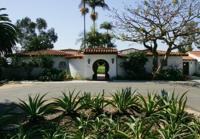
Casa Romantica. Staff photo
San Clemente is considered by many to be a true paradise. For years it’s sunny climate, pristine beaches, and Spanish-style charm have lured residents of all ages. However, in the 1920’s, the area that is now the beautiful city of San Clemente was little more than natural foliage and rolling hills. Located at the south tip of Orange County, the area would have provided an excellent vacation spot for residents of Los Angeles and San Diego, but it remained unknown because none of the land had yet been developed. That all changed with town founder Ole Hanson.
Ole Hanson was an American politician born in 1874. In 1918, he became the Mayor of Seattle, where he had formerly served on the Washington House of Representatives. In 1925, Hanson left Washington and came to Southern California, where he eventually purchased the 2,000-acre plot of land that was to become San Clemente. The land had previously been owned by several different individuals, but Ole was the first owner who planned to develop the area and start a community. Ole felt that the warm weather and ideal location would draw the attention of people yearning to escape the “big city” feel. However, before any construction started, the city’s founder laid out an entire plan, with all architecture based on Spanish Colonial design.
Initially, Ole Hanson’s ideas were met with rejection. People felt that investing in building a city that was an hour away from Southern California’s two main urban centers was financial ruin destined to happen. But on a rainy December day in 1925, over 600 Los Angeles inhabitants ventured down to the undeveloped plot to hear Ole’s real estate presentation. Ole funded luxury transportation and meals for interested buyers, which proved to be money well spent. In six months, Ole had sold over 1,200 lots, with the average real estate price at $300. In the midst of his financial success, Hanson was sure to remember his initial plan of a Spanish-inspired town. Each home ownership deed was issued with a mandate requiring that all builders adhere to strict design guidelines. Whitewashed stucco walls and red tile roofs became prevalent in San Clemente and reminiscent of the original buildings established by the first Spanish settlers.
Ole himself was unable to resist the allure of this “Spanish Village by the Sea” and built a personal home atop a bluff facing San Clemente’s iconic pier. The villa style home, known as Casa Romantica, was completed in 1928, but Ole lost the property during the Great Depression. Following the bank’s confiscation of Casa Romantica, the home passed through the hands of several different owners, but eventually fell in to a state of neglect. Demolition, it seemed, was the most probable outcome for the former home of the city’s founder. Luckily, San Clemente activists led a campaign to preserve the historic house, and succeeded in converting the building in to San Clemente’s cultural and historical Center. Generous donations from city residents restored Casa Romantica to its former glory. Currently, the Casa provides educational courses as well as presentations by performing and visual arts groups.
Today, San Clemente strays from the original Spanish vision that Ole Hanson established. However, current residents often look to the past to gain a greater appreciation for the city, as well as to preserve traces of the original Spanish charm that San Clemente was known for. Vendors – specifically those in south San Clemente – have worked to design store facades in accordance with the white walled, red roofed style that distinguishes the city. In addition to Casa Romantica, the Ole Hanson Beach Club, located adjacent to North Beach, is an original pool facility built by Ole during San Clemente’s development. The historical vibe, combined with the natural beauty and perfect location of the city has made it a prime real estate spot. Now home to over 68,000 residents, the city has truly been modeled to embody the best of what California has to offer.


